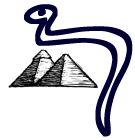
Some time between about 3000 and 2500 BC, Canaanite people working in Egypt adapted Egyptian Hieroglyphs to write their Semitic language, which was the ancestor of Phoenician, Moabite, Ammonite and Hebrew. They used a small number of hieroglyphs to represent the consonant sounds of their language and created what was probably the first alphabetic script. Many of the alphabets we used today are descendants of that first abjad.
According to ScienceDaily, a text written partly in this ancient script has finally been deciphered after confounding scholars for over a century since it was discover on the wall of the pyramid of King Unas at Saqqara in Egypt. One reason why it was so difficult to decipher was that everyone had assumed that the text was in Ancient Egyptian. However in 2002, Robert Ritner, professor of Egyptology at the University of Chicago, realised that part of the text was in another language, and this enabled Prof. Richard Steiner, professor of Semitic languages and literature at Yeshiva University in New York, to figure out that the text contained both Ancient Egyptian and an ancient Semitic language, and to decipher it.
The text is thought to be a spell to protect royal mummies against poisonous snakes and reads “Utterance of rir-rir mother snake, mother snake.” The words “rir-rir” refer to the drivel, the venom of the snake.
That is REALLY cool…one question, though. Is this single sentence the one sample we have of this form of Proto-Semitic, or is there more of it out there?
This text, which is actually longer than the translation above, according to this site, is currently the earliest known text in Proto-Semitic.
It’s not Proto-Semitic, it’s Proto-Canaanite. Proto-Semitic is likely to be much older and must incorporate aspects of Eastern and Southern Semitic as well as West central Semitic (Arabo-Canaanite).
Southern Semitic involves Amharic?
Good site. Thanks!
http://www.forumsdot.com/teamer/functions/loan3.htm education loans